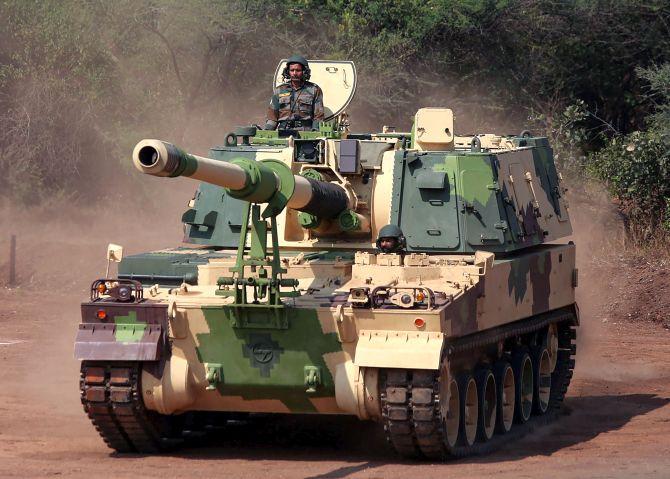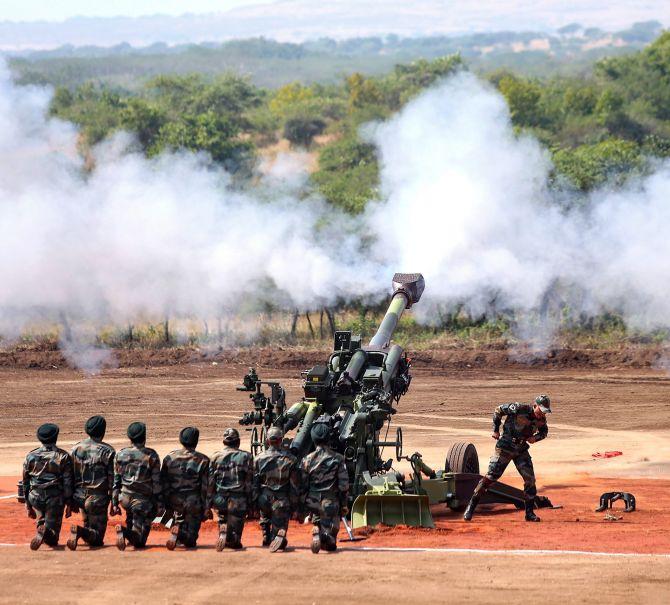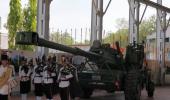'Landmark developments herald the end of two decades of stagnation in the army's modernisation plans,' notes Brigadier Gurmeet Kanwal (retd).

On April 8, 2019, the Ordnance Factories Board handed over the first four indigenously manufactured Dhanush 155mm/45 calibre guns to the army.
Earlier, at a function held at the field firing ranges of the School of Artillery, Deolali, on November 9, 2018 and presided over by Defence Minister Nirmala Sitharaman, two new weapons systems and a gun towing vehicle were formally inducted into operational service in the Regiment of Artillery.
The weapons systems included the 155 mm/39 calibreM777 A2 Ultra-Light Howitzer of US origin and the K-9 Vajra self-propelled 155 mm/52 calibregun from South Korea.
Since the purchase of 400 pieces of the Bofors 155 mm/39 calibre FH77B in the mid-1980s from Sweden, these two guns were the first modern weapons systems to be inducted into the Indian artillery.
These landmark developments herald the end of two decades of stagnation in the army's modernisation plans. Though India had paid for the designs while purchasing 400 pieces of the Bofors 155 mm/39-calibre FH-77B Bofors howitzer in the mid-1980s, the guns were never manufactured locally as commissions were alleged to have been paid and the Bofors scam had brought down a government.
The artillery is now equipped with obsolescent weapons and equipment like the 105 mm Indian Field Gun, the 122 mm Howitzer, the 130 mm Catapult self-propelled gun and 120 mm mortars.
The artillery requires large quantities of PGMs for the destruction of hard targets such as tanks and bunkers and a potent real-time reconnaissance, surveillance and target acquisition (RSTA) capability.
And, in view of their performance in Afghanistan and Iraq, the time has come to add UCAVs armed with PGMs to the artillery's arsenal. Only then will it be possible to achieve future military aims and objectives, including the large-scale destruction of the adversary's war machinery.
Under the army's Field Artillery Rationalisation Plan (FARP) formulated in 1999, the Regiment of Artillery had obtained the chief of the army staff's approval to standardise the calibre of its guns at 155 mm so as to be able to engage targets deep inside enemy lines and to reduce the logistics trail through commonality of ammunition.
The artillery plans to acquire a total of 2,820 guns of all types to replace obsolescent guns and to equip the new regiments that will form part of 17 Corps, the newly raised Mountain Strike Corps.

New acquisitions have begun to now move forward. The government has approved the acquisition of 145 pieces of 155 mm/39-calibre M777 howitzer through the Foreign Military Sales route in a government-to-government deal worth $750 million. The gun has a range of 24 km and weighs 4,000 kg.
This weapon system, manufactured by the US-based MNC BAE Systems, will equip seven regiments in the mountains. It will take a few years before all the guns are delivered.
While the first 20 pieces will be imported, the remaining 125 guns will be assembled in India, possibly by a joint venture with Mahindra Defence as the Indian partner.
The design of the indigenously manufactured Dhanush was initially based on the Bofors design, but has matured into an indigenous design during development. The gun has a maximum range of 38 km. It has been reported that an order for 114 guns has been placed on the OFB with the option to buy 414 additional guns.
The acquisition of 814 truck-mounted self-propelled guns for semi-desert terrain has also been approved by the Defence Acquisition Council and will be undertaken under the 'buy and make in India' category with the transfer of technology.
While the first 100 guns will be imported, the remaining 714 will be manufactured in India.
The total project cost is estimated to be around Rs 16,000 crore. Bharat Forge (partner Elbit of Israel), Tata Power SED (Denel, South Africa) and L&T (Nexter, France) are known to be interested in this project.
180 pieces of 130 mm M-46 Russian guns have been upgraded to 155mm/45-calibre with kits supplied by Soltam of Israel. The maximum range of the gun has gone up from 27.5 to 39 km. India can exercise an option to upgrade another 250 to 300 guns in future as a 'buy and make in India' project.
The single largest artillery acquisition will be of 1,580 pieces of towed 155 mm/52-calibre guns over a period of 12 to 15 years. Of these, 400 guns are to be imported and the remaining 1,180 produced in India with ToT.
Over the last eight to 10 years, several RfPs that were floated for this project were cancelled allegedly due to the corrupt practices followed by some companies. New tenders were floated for these 155 mm/52-calibre long-range guns for the plains and trials are reported to have been completed. The two contenders are joint ventures between Bharat Forge and Elbit and L&T and Nexter of France.
DRDO has embarked on its own venture to design and develop a 155 mm/52-calibre Advanced Towed Artillery Gun System (ATAGS) in partnership with Bharat Forge and Tata Power SED, both private sector companies.
While Bharat Forge will manufacture the gun, Tata Power SED will provide the electronics. Efforts are also underway to mount a 130 mm gun on an Arjun tank chassis as a replacement for the Catapult, which had a 130 mm gun on a Vijayant tank chassis. 155 mm ammunition is now being manufactured indigenously, but some fuses are still being acquired from abroad.
Progress on the multi-barrel rocket launcher front has been better than that in the acquisition of tube artillery. A contract for the acquisition of three regiments of the 12-tube, 300 mm Smerch multi-barrel rocket launcher (MBRL) system with 90 km range was signed with Russia's Rosoboron export in early-2006. Each artillery division now has a regiment of this potent weapon system.
Three regiments of the indigenously designed 214 mm Pinaka multi-barrel rocket system, manufactured jointly by the Tatas and L&T, have also been inducted into service. While the Pinaka has a range of 37 km at present, the Mark 2 version of the rocket will have a range of 60 km. However, both these weapon systems are not suitable for employment in mountainous terrain.
The BrahMos supersonic cruise missile (Mach 2.8 to 3.0), jointly developed with Russia, has precision strike capability, very high kill energy and maximum range of 290 km. It was first inducted into the army in July 2007. The number of BrahMos regiments has since gone up to three. The fourth regiment to be inducted will have 'steep dive' capability for the mountains.
These terrain hugging missiles are virtually immune to counter measures due to their high speed and very low radar cross section. After India signed the Missile Technology Control Regime, efforts have begun to increase the range to 400 to 500 km.
India should consider exporting the BrahMos missile system to achieve foreign policy objectives; for example to Vietnam. The Grad BM-21 MBRL regiments, which have been in service for almost three decades, are being given extended range rockets that have a maximum range of 40 km.
These four missile and rocket launcher weapon systems will together provide a major boost to the artillery's ability to destroy key targets at long ranges. However, a surface-to-surface missile with a range of 500 km to 600 km, which can be fired from the plains to destroy targets in Tibet, is a crucial missing link in planning for a future war in the mountains.
Brigadier Gurmeet Kanwal (retd) is a former Director, Centre for Land Warfare Studies (CLAWS), New Delhi.










